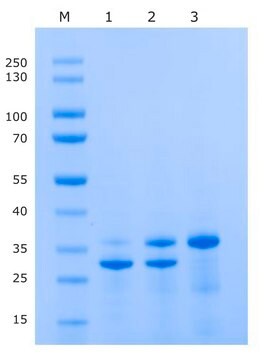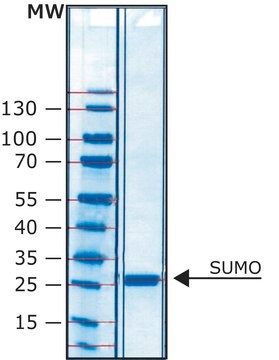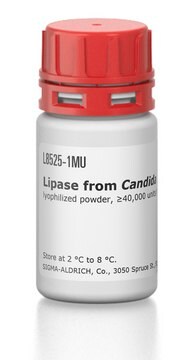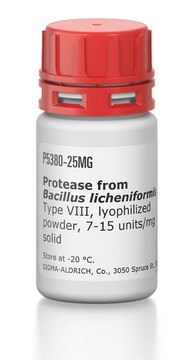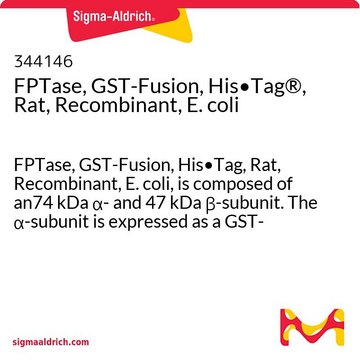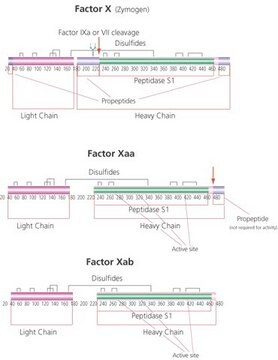Key Documents
T4455
TEV Protease
Synonim(y):
P1 protease, TEVp, Tobacco Etch Virus protease, rTEV
About This Item
Polecane produkty
pochodzenie biologiczne
microbial (Tobacco Etch virus)
Poziom jakości
rekombinowane
expressed in E. coli
opis
Contains both a histidine tag and a GST tag
Postać
solution
aktywność właściwa
≥3,000 units/mg protein
masa cząsteczkowa
27 kDa
metody
protein purification: suitable
przydatność
suitable for purification of HIS tagged recombinant proteins
Zastosowanie
genomic analysis
Warunki transportu
wet ice
temp. przechowywania
−20°C
Opis ogólny
Zastosowanie
Działania biochem./fizjol.
Cechy i korzyści
Właściwości fizyczne
Definicja jednostki
Postać fizyczna
Uwaga dotycząca przygotowania
Prepare fresh dialysis buffer. Dialysis buffer should be optimized for target protein solubility and contain no protease inhibitors. The dialysis buffer should also be compatible with downstream purification processes, e.g. minimal amount of EDTA or DTT if a HIS Select® column will be used to remove the cleaved His-tag.
Example of suitable dialysis buffer; 25 mM Tris-HCl, pH 8.0, 150 - 500 mM NaCl, 14 mM β-mercaptoethanol
This TEV protease has the same activity in 150 mM NaCl or 500 mM NaCl and 400 mM imidazole.
Dilute the target protein sample to 1-2 mg/ml with dialysis buffer. This is optional in case the target protein aggregates in dialysis buffer. Save a small aliquot as a control for PAGE analysis. EDTA may be added to 0.5 mM final concentration if the target protein will be eluted from the HIS Select™ column and EDTA is compatible with the target protein.
Add TEV protease at a protease to target protein ratio of 1:100 (w/w) or 10,000 unit (1 mg) TEV protease to 100 mg of target protein. There is no need to calculate the molar ratio. TEV protease can be added directly to the target protein. There is no need to change buffer or dilute TEV protease. The optimal ratio should be determined empirically. A Protease-to-target protein ratio (w/w) of 1:50 to 1:200 should provide an affective range for most target proteins.
Dialyze against the dialysis buffer at 4 °C ~ 16 hrs. Dialysis is intended to remove imidazole or glutathione if HIS Select® or glutathione affinity columns are used to remove the cleaved tag or TEV protease after cleavage.
Typically, 1 mg of TEV protease will cleave >90% of 100mg of a control protein at 4 °C in 16 hours.
Informacje prawne
Kod klasy składowania
10 - Combustible liquids
Klasa zagrożenia wodnego (WGK)
WGK 2
Temperatura zapłonu (°F)
Not applicable
Temperatura zapłonu (°C)
Not applicable
Certyfikaty analizy (CoA)
Poszukaj Certyfikaty analizy (CoA), wpisując numer partii/serii produktów. Numery serii i partii można znaleźć na etykiecie produktu po słowach „seria” lub „partia”.
Masz już ten produkt?
Dokumenty związane z niedawno zakupionymi produktami zostały zamieszczone w Bibliotece dokumentów.
Klienci oglądali również te produkty
Produkty
Read our article about how the Nanodisc system allows for structural studies of membrane proteins.
This page shows how to perform a purification of His-tagged membrane proteins.
Ta strona pokazuje, jak przeprowadzić oczyszczanie białek błonowych znakowanych His.
Nasz zespół naukowców ma doświadczenie we wszystkich obszarach badań, w tym w naukach przyrodniczych, materiałoznawstwie, syntezie chemicznej, chromatografii, analityce i wielu innych dziedzinach.
Skontaktuj się z zespołem ds. pomocy technicznej

